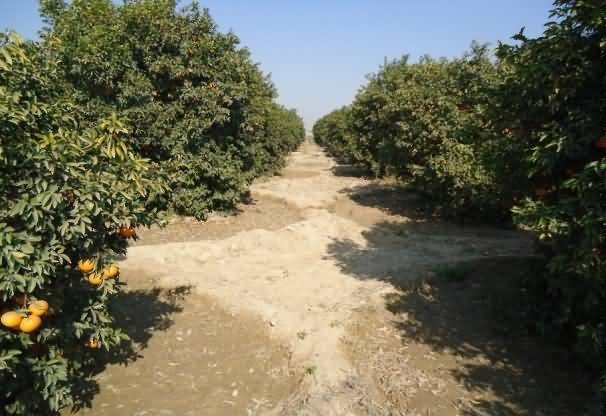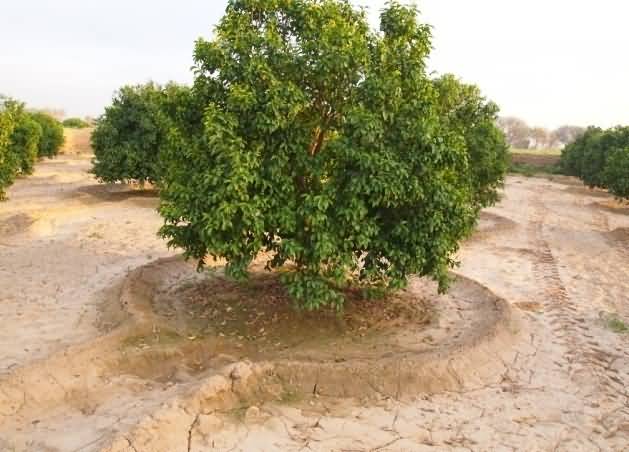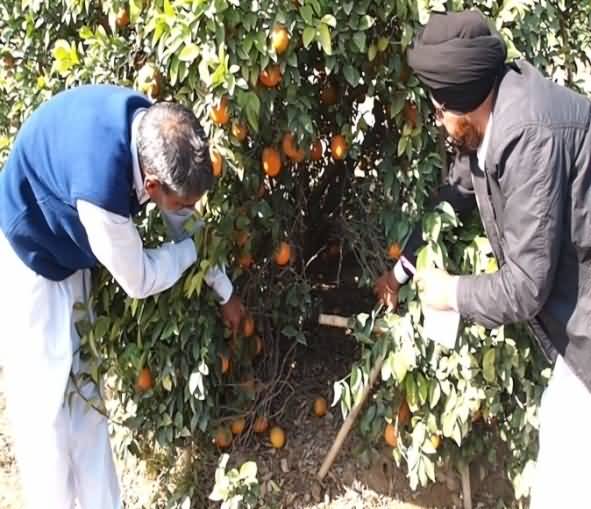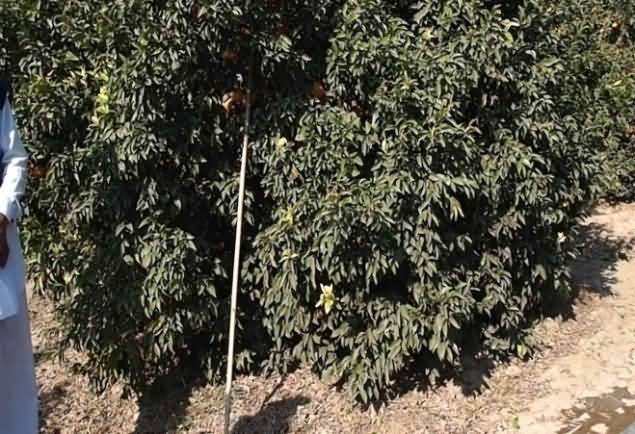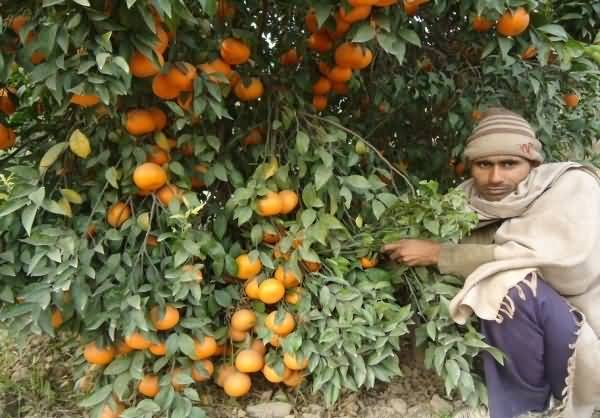
Mr. Harvindra Singh Brar is resident of village 10 Q, District Sriganganagar, Rajasthan, India which is located between 2804’ to 3006’ North latitude and 72030’ to 75030’ East longitude. He has deep soil and orchard is present in canal command area.
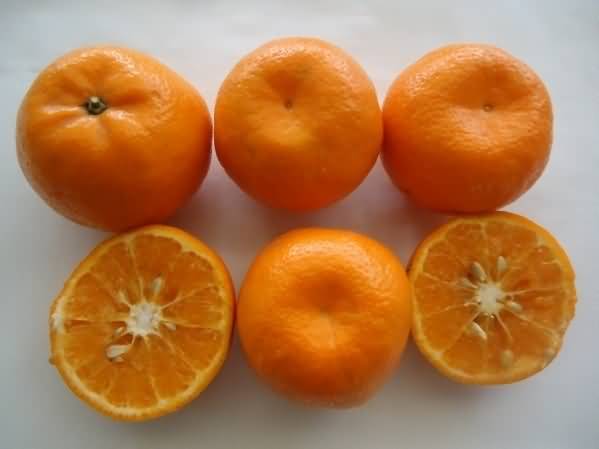 The orchard prevail extreme climatic conditions with the scorching summer, cold winter and mild rainy season. Dust storms during summer, frosty winter nights and ground fog are some of the typical features of weather hazards. The average rainfall in the zone ranged from 185 to 590 mm. On an average 75 per cent of the total rainfall received from June to September.
The orchard prevail extreme climatic conditions with the scorching summer, cold winter and mild rainy season. Dust storms during summer, frosty winter nights and ground fog are some of the typical features of weather hazards. The average rainfall in the zone ranged from 185 to 590 mm. On an average 75 per cent of the total rainfall received from June to September.
The temperature in the zone fluctuates from as low as 10C to as high as 480C. June is the hottest month and January is the coldest month of the year. The average monthly pan evaporation fluctuates from 49.4 mm in December to 337.6 mm in May with annual value of 1865.7 mm.
Problem:
Mr Brar belongs to farming community and has Kinnow orchard on flood irrigation in an area of two hectares. During summer season, due to extreme temperature, water scarcity and canal closers for 30 to 50 days in the month of April to May, cause severe fruit drop in Kinnow orchard resulting poor fruit yield and quality.
Strategy followed:
After completion of post graduate studies, Mr. Brar came in contact of farmers engaged in organic crop production and in addition, he contacted Agricultural Research Station Sriganganagar to seek help for technical support. He realized that moisture conservation and improvement of soil health can only solve their problem.
He was also not in favour of excessive use of inorganic fertilizers and pesticides as he experienced good quality fruits and better plant health in organically grown orchards. He expressed his desire to establish orchard on organic resources and planned for integrated moisture conservation applications.
Nutrient management:
Since last 8 years he never applied in-organic source of fertilizers. Annually he applies 10-15 Kg of well rotten farm yard manure per plant duly multiplied with Tricoderma harzianum @ 60-70 g per plant. Rest of the nutrient requirement is made available with the application of crop residues or mulching.
Irrigation method:
He has established orchard on flood irrigation. In young orchard (5-10 years old) he makes a ring (1.5 to 2 feet wide and o.5 feet deep) near outside periphery of the plant canopy. Dig out soil of the ring were placed below the tree canopy by keeping soil level 0.5 feet higher than the irrigation ring made outside of the canopy.
Due to elevated soil level from main trunk to inner periphery of the plant canopy, applied water never comes in contact to main trunk. Water is applied mere in outer ring made outside the canopy.
In old orchard he made 3-4 feet wide channel in between two plant rows and apply irrigation water in channels only and soil of plant canopy kept elevated to avoid water stagnation near trunk area.
Mulching:
For mulching practices, he apply crop residue of mustard or guar or moong or sugar cane trash or paddy straw below the plant canopy as well as in irrigation ring made 1.5 feet away from the canopy. He never picked dried leaves or thinly dropped dry branches below the canopy. Application of mulch reduces soil temperature, provides nutrients after decomposition, improves water holding capacity and reduces evapo-transpiration losses by saving irrigation water.
Plant protection:
To control insects like leaf minor, Citrus psylla, thrips, mites he applies Azadiractin or neem oil @ 4-5 ml per liter during active growth period or as and when required. Due to controlled irrigation, avoidance of water stagnation near the tree trunk, their plants are almost free from soil born pathological diseases.
For pathological fruit drop he sprays Trichoderma or Pseudomonas. In addition he also make Jeevamrit by mixing 10 Kg cow dung + 5 litre cow urine + 1-2 Kg Jaggry (gur) + 1-2 kg besan (gram flour) + 1-2 kg un cultivated soil dissolved in 200 liter of water and kept for fermentation for 6-7 days. Prepared Jeewamrit was used to spray on foliage as well as applied in soil @ 3-4 liter per plant.
According to Mr Brar mulching and non use of in organic fertilizers and pesticides, increases the soil microbes, earth worm population and eco-friendly insects and predators like Crysoperlla spp., Coccinalids, ants, Syrphid fly, spider and honey bee.
Fruit yield and quality:
Organically grown fruits always preferred in the market. Due to controlled irrigation he get good blend of TSS and acids in the fruit. Their fruits contain 13- to 15 degree Brix TSS as compared to 9-10 degree Brix in conventionally flood irrigated non organic orchards.
He get fruit yield 1.5 – 2.5 quintals per plant at the age of 9-10 years however many plants give up to 4 - 4.5 quintals fruit yield. Mr Brar on average earns Rs 4.5 – 5 lacs per hectares however his investment including labour comes to mere Rs. 50 – 60 thousands per hectare.
Conclusion:
Mr. Brar is fully happy and satisfied with organic Kinnow production as well as mulching benefits and developed moisture conservation techniques. He never applies water inside the plant canopy which results in healthy plant growth, improved fruit yield and quality and least incidence of insect pest and diseases.
AICRP Tropical fruit team of ARS Sriganganagar many times visited their field and gave required technical inputs. His orchard serve as a role model in the area and his success must be replicated in other Citrus growing areas.
1. जैविक किन्नू उत्पादन 2. कैनोपी के अंदर फलन 3.कैनापी के बाहर सिंचाई का घेरा

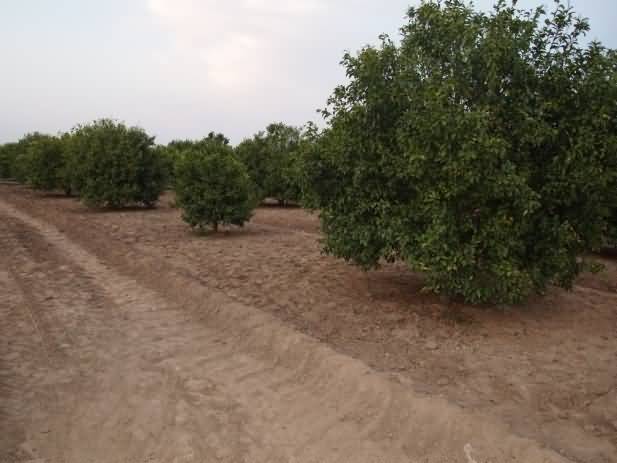
4. तना क्षेत्र के पास ऊंची मिट्टी 5.परंपरागत घेरा और 6. बाढ़ सिंचाई जिससे रूट रोट रोग होता है
7.कैनोपी के नीचे सूखे पत्ता जमाव 8. गुच्छा में किन्नो फलन 9. जैविक विधि से उच्च गुणवत्ता के किन्नू फल
Authors:
Dr. A.K. Srivasatava, Assistant Professor (Hort.) and Dr. S.K. Bairwa, Assistant Professor (P.Pathol.),
AICRP on Fruits, ARS, SKRAU, Sriganganagar, Rajasthan 335001 INDIA
Email:


